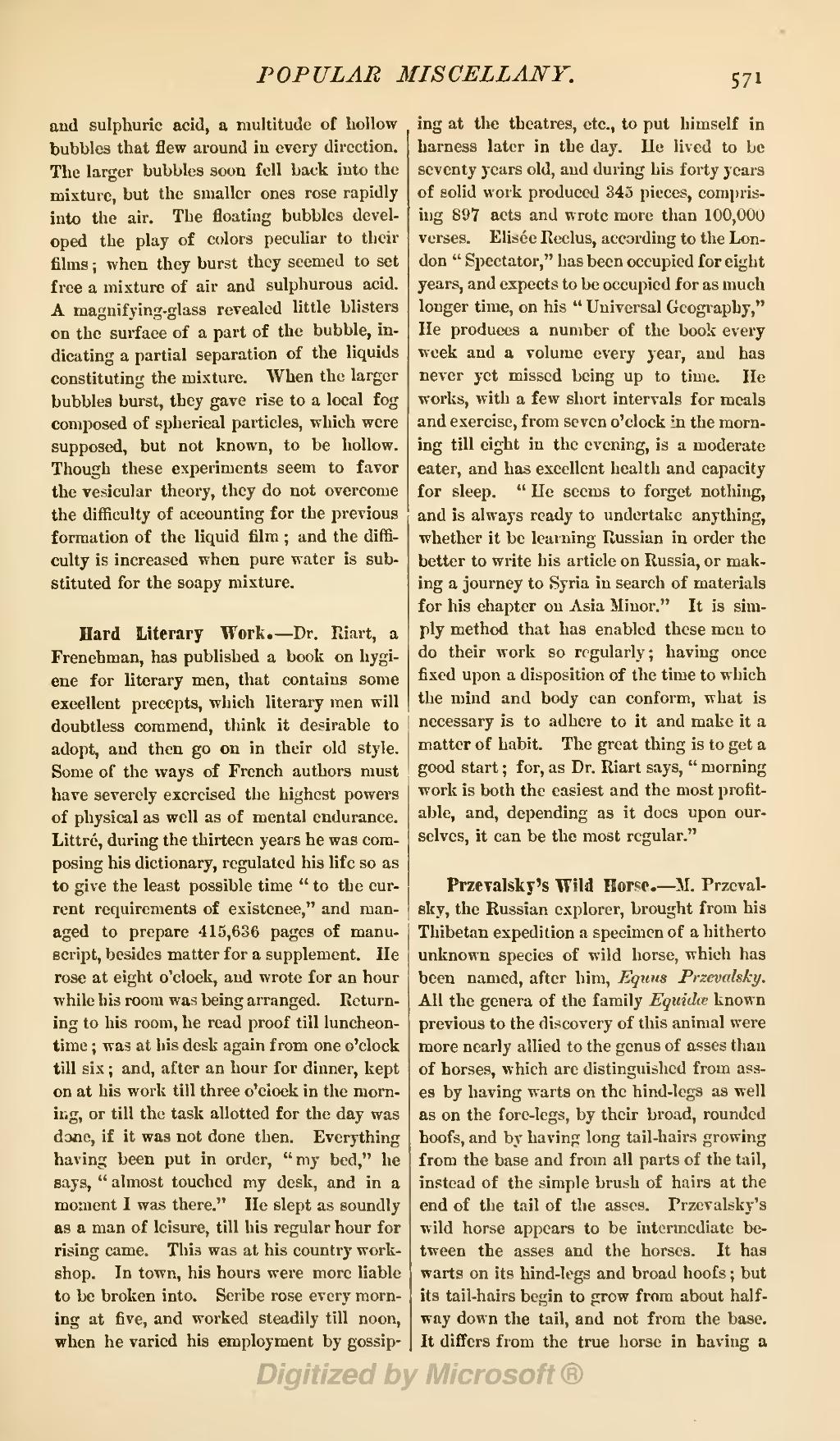and sulphuric acid, a multitude of hollow bubbles that flew around in every direction. The larger bubbles soon fell back into the mixture, but the smaller ones rose rapidly into the air. The floating bubbles developed the play of colors peculiar to their films; when they burst they seemed to set free a mixture of air and sulphurous acid. A magnifying-glass revealed little blisters on the surface of a part of the bubble, indicating a partial separation of the liquids constituting the mixture. When the larger bubbles burst, they gave rise to a local fog composed of spherical particles, which were supposed, but not known, to be hollow. Though these experiments seem to favor the vesicular theory, they do not overcome the difficulty of accounting for the previous formation of the liquid film; and the difficulty is increased when pure water is substituted for the soapy mixture.
Hard Literary Work.—Dr. Riart, a Frenchman, has published a book on hygiene for literary men, that contains some excellent precepts, which literary men will doubtless commend, think it desirable to adopt, and then go on in their old style. Some of the ways of French authors must have severely exercised the highest powers of physical as well as of mental endurance. Littré, during the thirteen years he was composing his dictionary, regulated his life so as to give the least possible time "to the current requirements of existence," and managed to prepare 415,636 pages of manuscript, besides matter for a supplement. He rose at eight o'clock, and wrote for an hour while his room was being arranged. Returning to his room, he read proof till luncheon time; was at his desk again from one o'clock till six; and, after an hour for dinner, kept on at his work till three o'clock in the morning, or till the task allotted for the day was done, if it was not done then. Everything having been put in order, "my bed," he says, "almost touched my desk, and in a moment I was there." he slept as soundly as a man of leisure, till his regular hour for rising came. This was at his country workshop. In town, his hours were more liable to be broken into. Scribe rose every morning at five, and worked steadily till noon, when he varied his employment by gossiping at the theatres, etc., to put himself in harness later in the day. He lived to be seventy years old, and during his forty years of solid work produced 345 pieces, comprising 897 acts and wrote more than 100,000 verses. Elisée Reclus, according to the London "Spectator," has been occupied for eight years, and expects to be occupied for as much longer time, on his "Universal Geography," He produces a number of the book every week and a volume every year, and has never yet missed being up to time. He works, with a few short intervals for meals and exercise, from seven o'clock in the morning till eight in the evening, is a moderate eater, and has excellent health and capacity for sleep. "He seems to forget nothing, and is always ready to undertake anything, whether it be learning Russian in order the better to write his article on Russia, or making a journey to Syria in search of materials for his chapter on Asia Minor." It is simply method that has enabled these men to do their work so regularly; having once fixed upon a disposition of the time to which the mind and body can conform, what is necessary is to adhere to it and make it a matter of habit. The great thing is to get a good start; for, as Dr. Riart says, "morning work is both the easiest and the most profitable, and, depending as it does upon ourselves, it can be the most regular."
Przevalsky's Wild Horse.—M. Przevalsky, the Russian explorer, brought from his Thibetan expedition a specimen of a hitherto unknown species of wild horse, which has been named, after him, Equus Przevalsky. All the genera of the family Equidæ known previous to the discovery of this animal were more nearly allied to the genus of asses than of horses, which are distinguished from asses by having warts on the hind-logs as well as on the fore-legs, by their broad, rounded hoofs, and by having long tail-hairs growing from the base and from all parts of the tail, instead of the simple brush of hairs at the end of the tail of the asses. Przevalsky's wild horse appears to be intermediate between the asses and the horses. It has warts on its hind-legs and broad hoofs; but its tail-hairs begin to grow from about halfway down the tail, and not from the base. It differs from the true horse in having a

